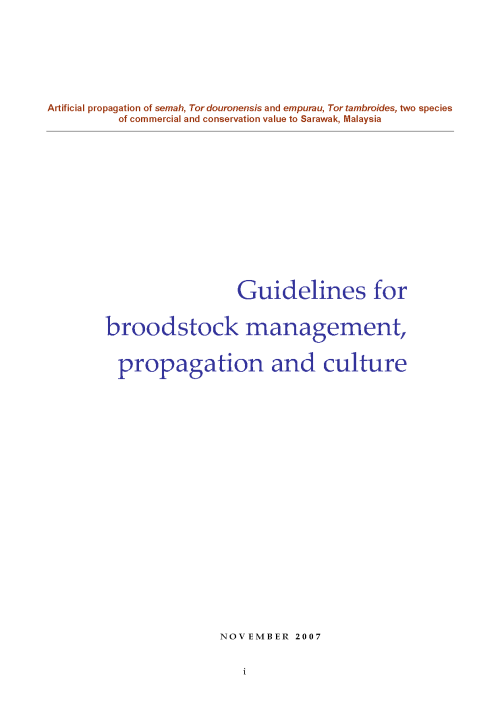Guidelines for broodstock management, propagation and culture of semah, Tor douronensis and empurau, Tor tambroides
7 January 2008 | 5677 Downloads | .pdf | 1.23 MB | Better management practices, Genetics and Biodiversity, Hatchery and nursery
Tor tambroides and T. douronensis, locally referred to as semah and empurau, respectively, are high valued mahseer species, indigenous to Sarawak, East Malaysia, with an aquaculture potential and of conservational value. These two indigenous species live in headwaters of most major river systems of this state. These two species also occur in Peninsular Malaysia and are distributed throughout south-east Asia from Indonesia to southern China (Kottelat et al. 1993, Roberts 1999, Zhou and Cui 1996). Semah is the State Fish of Sarawak, and both species currently fetch a very high market price are of high cultural value. Juveniles of these two species are also increasingly sought after by the aquarium industry (Ng 2004).
The Government of Sarawak, recognising the importance of these two species, made an attempt to evaluate their aquaculture potential, including captive breeding using long-term pond-reared broodstock, commencing in the 1990s. However, limited success was achieved until the period 2002-2004 when, in an international collaboration, researchers from Australia and Sarawak were able to captive breed both species using hormone induction techniques on long-term, pond-reared broodstock.
The Project 'Artificial propagation of empurau, Tor tambroides and semah, Tor douronensis, two species of commercial and conservation value to Sarawak, Malaysia', commenced in April 2001, and was successfully carried out over a four- year period. The Project accomplished the primary objectives, and the most outstanding achievements were the success in the captive breeding of the semah and empurau, and the training of the Malaysian officers in adopting the techniques, as a routine, and the successes in the larval to fingerling rearing of the two species escaped/released on the genetic diversity of the wild counterparts. As such, a genetic management plan is needed to warrant longterm maintenance of genetic diversity of cultured stocks, as well as to minimise potential adverse effects on the genetic integrity of the wild populations.
The recent successful hatchery production of semah and empurau brought to the forefront problematic questions regarding sustainability of the aquaculture development and stock enhancement program of these two species. From an environmental point of view, aquaculture and stock enhancement could be counter-productive if not properly managed, especially with regard to the potential negative impacts of hatchery-produced seed.
In the above context an enhancement strategy for the long-term management of semah and empurau broodstock, and conservation of wild stocks, based on genetic findings will be discussed in this guidelines. In addition, the guidelines also incorporate best husbandry management practices to ensure a supply of physically and genetically healthy quality seed.
Creative Commons Attribution.

